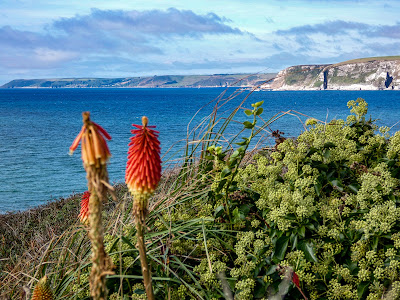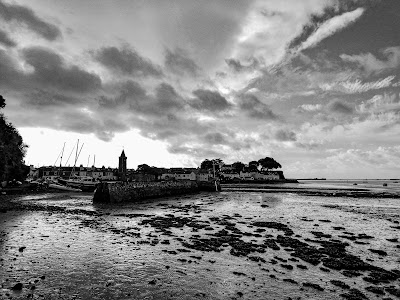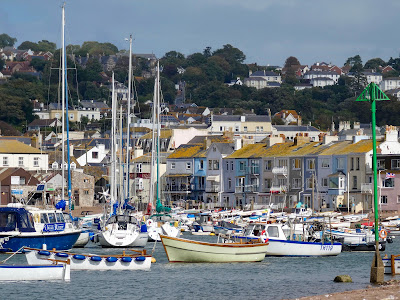Seaside Special - Mother Nature’s playground: South Devon
Ah, Devon. Here’s another excuse to dip a toe in the calming waters of nostalgia.
The English Riviera was our family holiday destination on repeat play during the early 80’s. Like Weymouth and the jumping-off point for the Channel Islands in the previous episode, Paignton represented full value for my Dad’s British Rail family pass. We would hop on a cross-country express at York and let the train take the strain for the next 320 miles, scoffing my Mum’s potted meat sarnies and playing endless games of travel Mastermind.
Paignton seemed to suit us all with its understated blend of seaside attractions. I remember loving the aircraft museum, Dad was happy with the steam railway, Mum had a fair crack at winning a giant bear on the bingo and Bruv backed a horse at a Newton Abbot evening meeting that got stuck astride the final fence when clear in the lead. All the ingredients for a perfect Summer holiday.
Over the years, South Devon has had a more permanent pull on some of our friends who, not content with mere holidays, have taken the plunge to relocate here. Having mates dotted along the coastal hinterland is always a bonus when it comes to local knowledge for, say, finding superb fish and chips in The Start Bay Inn at Torcross, or teasing the breakers of a quiet high summer beach at Gara Rock. Or, on one memorable occasion, directing me to Exeter A&E where one eye saw Sol Campbell on a grainy telly nod in a header for England against Sweden in the 2002 World Cup, whilst the other was being treated for a batch of corneal ulcers. Ouch.
One of those relocating mates has appeared in these posts previously. Roo moved to Devon years ago and is now retired. The Holy Grail. Mind you, he was always a lazy git when it came to actual work, so in some ways the change in circumstances has not been that simple to detect. I called on him whilst on the way back from Cornwall (a forthcoming episode) in 2018 and stayed overnight with him in Ivybridge, a few miles east of Plymouth.
He was by then putting his newly established status as a man of leisure to good use. I became equally envious of his proximity to the magnificent south Devon coastline.
Joined by the lovely Mandy, we meandered across the cliffs and inlets between Ayrmer Cove, Bigbury-on-Sea and Burgh Island. Mandy’s knowledge of flora, fauna and landscape was outstanding, having previously led guided walks around the area. So here comes the geology spot again. Oh schist, I hear you say. Spot on. Slabs and slabs of it, formed as spectacular angular layers of cliff. Sharp and grey uplifted slices of rock sticking out at 45 degrees like the broken blades of knives on a giant scale. A knife block in reverse.
There was time for a sit and a sandwich at Challaborough Beach. This was where Roo’s son Joe came surfing; and where he himself does, but only on calm days when the dangerous rip current is behaving itself. On that day, there was no surfing to be seen at all. Too still. The beach was populated by dog walkers – mainly spaniels for some reason – and a few sea fishermen sitting close to the waterline and casting into the gentle froth.
Burgh Island Hotel is another entry on my increasingly unrealistic wish list. Cut off at high tide, there’s a little tractor and trailer that takes visitors across the shimmering sands from Bigbury to the island, where the art deco hotel dominates with its own harbour, extensive grounds and lodges; and where glamour, luxury and opulence are on gilded tap. Agathe Christie wrote two books on the island. Does this sound like an advert? Well I’m happy to take a free night or two as a bung if you are reading this, Mr and Mrs Burgh? (As I write, a midweek night in February would set you back £505. There is only one eye-wateringly expensive weekend date available between now and June).
On the train home, the late afternoon sun picked out the sea cutting up around Torbay with an onshore breeze provoking tiny white crests of surf. Around the next estuary, Exmouth was gleaming across the water in the Autumn sunshine backed by red Devonian Sandstone cliffs. The estuary looked so good I decided to visit.
But it took another year for the trip to happen. Life takes over. And there were other trips to make as well. Eventually I found time for a brief retreat from the noise, clutter and aggravation of the commuting hamster wheel. I’d been working in Kentish Town during 2019 when knife crime was accelerating and the capital was seeing more deaths amongst under-25s than any time in the last 10 years. There had been fatal stabbing outside two of the organisations I worked for within three months. Desperate for the families and for the communities.
Lympstone, my chosen bolt-hole for a couple of nights on that Exe estuary glimpsed from across the water, provided an antidote of calm. No-one in the vicinity was mugged or knifed in the three days I was there. I barely heard a voice raised in agitation or impatience. I didn’t even spot a single 4x4 parked across the pavement.
There’s always a frisson of excitement when I’m bearing down on my next destination. These days there is so much information available to suss out locations before arrival, be it Google Earth, TripAdvisor, OS online and even – how 20th Century – guidebooks and paper maps. But you can never know everything. Judiciously cropped photos, inaccurate opening times, noisy neighbours, jaundiced reviews... Indeed what would be the point? Anticipation is everything. And if expectations sometimes exceed reality, well that’s ok too. I’m thinking Bognor here.
For these reasons, I had an open mind about Lympstone. I had done my research and the place seemed to tick most of the boxes on my wishlist. And this time, reality matched up to expectation.
From a couple of miles up the line, I was getting good vibes. The two carriage branch line service had left Exeter to crawl through the city’s surprisingly extensive suburbia and then dormitory settlements separated by leafy woodlands, before a couple of twists of the rails brought us out into full view of the estuary.
The stop before my destination was Lympstone Commando. This must be the best named station I've ever called at. To be fair, these two platforms were not really part of the public rail network because they only served the home of the Royal Marines training centre. Large red signs above the station name along the platform made this very clear. ‘Do not alight unless you have business with the centre’. Eight-foot chain link fencing, sentry boxes and an abundance of camouflage rammed home the point. I put my camera away, just in case.
The village of Lympstone itself was very genteel in comparison. ‘Devon village of the year 2007’ exclaimed a sign by the station, inferring a very different intent to one I’d just seen up the line. I took my camera out again.
After I’d settled in to the airbnb with estuary views (tick) I succumbed to the inevitable and pottered around the foreshore at low tide giving myself up to the sunset, the water and the quiet. If I was ever to appear on Ken Bruce’s excellent Radio 2 Popmaster quiz and he asked me, as he surely would, ‘So Dave, tell me a little bit about yourself. What do you like to do when you’re not dodging knife attacks in Kentish Town?’ I’d say, ‘Well, Ken, what I really like to do is potter. It’s a very underestimated activity and I find I’m rather good at it.’ Lympstone was the most fantastic village for this kind of activity. An abundance of twisting narrow alleys, some that ended at the water, others that snaked inland. On the foreshore, dwellings seemed to be crammed into the tiniest, most geometrically challenging of spaces. All with some kind of vantage point out on to the estuary: gardens, balconies, terraces, windows, sheds.
I finally stopped taking photos from every angle, viewpoint and ledge. I finally stopped to breathe in and unexpectedly, involuntarily, felt my soul fill up. As easy as that. Like a hand-pulled real ale into my empty pint pot.
There was a bit more pottering of the mind to be had, if not the body. Stood on the harbour wall and looking back at the cottages along the estuary, I could make out a series of poles in the half-light, drilled into the sludge. Some upright, others leaning and all haphazardly connected by wires. An abandoned wartime flagpole signalling system I pondered as I navigated my way back to my berth?
Up early next morning for a coffee and pastry at Susannah’s, I noted those wires were actually clothes lines for the cottages, now hung with colourful t shirts, big pants and wet suits. The overactive imagination of a tired mind, eh? Susannah’s cafe used to be the post office but was very busy in its new guise, serving a few visitors who were still around even in the second week of October. And locals too, judging by the conversations, mostly centred on the road works up the lane causing tailbacks into Exmouth.
Looking out the window, I could see that a former bank was now a private house and at least two other holiday lets betrayed earlier uses as pubs. That’s not to say the place was without life – it was certainly no empty chocolate box of second homes and day trippers. Both pubs were busy, the posh restaurant up the hill was booked out, the Costcutter opened all hours, kids and parents walked to school down the roads, and there was regular train service.
It was to that railway I headed next. The Avocet Line. In common with nearly all rural branch lines, the Exeter-Exmouth route had been rebranded. A black and white depiction of the wader’s head and signature curved bill, with wings outstretched as if to make a courtesy, adorned all the information boards. The service was well used and at this earlyish hour, a collection of shoppers, commuters and visitors disembarked at Exmouth.
I pootled about the town, getting my bearings and feeling a little underwhelmed. The walk from the station took me behind some industrial units and marine businesses sprawling their rusting paraphernalia along the shore. I made my way to the marina which was another of those identikit redevelopment jobs that seemed to draw on Alpine chalets as inspiration for the flats that surrounded yachts below, with barely a nod to the town’s former port function. The sunlit glimpses of the town those many months before from across the estuary had promised so much more. The town was perfectly functional and accommodating, but I’d let my mind run away with the idea of something a little more picturesque.
I leant across the railings and looked over the lovely beach where a group of five or six red-life-jacketed middle aged men and women were learning the basics of paddle-boarding by splashing about in the light surf. Management awayday, I scoffed before admitting that it looked like top entertainment. Water sports appeared to be a growing interest in these parts, judging by the adverts for kite-surfing, water-skiing, para-gliding and boat hire.
On the other side of the marina, a passenger ferry was moored up against the harbour wall, embarking for Starcross. I hopped aboard for a perambulating route across the estuary avoiding boat wrecks, spits of land and the odd sandbank populated with basking seals.
Up on the fore deck I was chatting to a Danish couple who were also admiring the sunbathing seals. They were in the midst of tackling the South West Coast Path, aided by stuffed backpacks. I met quite a few groups undertaking this marathon venture in researching these blogs. This couple were easy going and relaxed to the point of not knowing where they might be staying that night. Their tightly wound packs did not include tents or sleeping bags. I was full of admiration for this because I’m not sure I’ve got the nerve. I like a bit of a plan.
We parted company on the Starcross jetty. We were all going south, but I picked up the train again and they struck out on foot. The rails hug the coast along this section of line and act as a barrier between the houses at Starcross and the estuary. There are only a few crossing points. The southbound platform is actually built out from the coast over the water. Looking down over the fence is a tad unnerving. This is, of course, just one small part of Isambard Kingdom Brunel’s remarkable south Devon railway engineering project. The line hits the coast adjacent to Powderham Sands about 5 miles north of this spot and sticks rigidly to the water’s edge across bridges, embankments and through red sandstone cliffs through Dawlish, Teignmouth and up the Teign estuary as far as Newton Abbot. I’ve ridden this line so many times and never get bored of it. The train ducking in and out of tunnels to give glimpse of the bays or turning through headland bends to give sweeping views in either direction. No funfair ride comes close.
It's a fragile beauty though. In February 2014 a massive storm hit Devon and Cornwall overnight and quite literally deposited chunks of this mainline connection into the briny at Dawlish. The storm had breached a wall between the sea and the railway line, washing it away, together with 80 metres of track, platforms at Dawlish railway station and sections of the coastal path. News bulletins carried pictures of the railway hanging like a rope bridge over a chasm where the embankment used to be.
 |
| BBC image |
Another storm on 14 February caused a breach of the temporary sea defences which had been constructed from welded-together shipping containers. And then on 4 March, just around the coast near Teignmouth, a controlled operation resulted in 20,000 tonnes of material being washed down from the cliff over the railway following another landslip. I was fascinated by this operation and read later on the Network Rail site that this part of the recovery plan alone involved using a high pressure water cannon, fire hoses, helicopter-borne water bombs, specialist roped access team and ‘spider’ excavators. Engineering can be so damn sexy!
In total, a team of over 300 took eight weeks to repair more than four miles of line. Such is the strategic importance of this mainline connection that costs to the economy were estimated at £1.2 billion.
Further work at Teignmouth was required in 2018 following another landslip. Network Rail is committed to maintaining the current railway route and as a result, there are plans for a new, higher and wider seawall in front of the existing wall at the resort. The delicate balance between natural elements and community sustainability is visceral here.
There’s a lot worth defending. Teignmouth gave me some of the picturesque qualities I found wanting in Exmouth. The train line ducks in-land after the station to follow the Teign estuary and as such forms the northern edge of a triangular spit of land surrounded by sea on two sides. The Esplanade on one side has the sea beach and Teignmouth Pier with amusement arcade and rides, and just behind the other side has the rather fine Den Crescent and its central Assembly Rooms. Laid out in 1826 this group survives relatively unchanged from its heyday.
The spit wraps round into the estuary where there is a river beach, known as the Back Beach. I found a pub - The Ship Inn of course - serving Cornwall’s fine Proper Job ale and in some warming Autumn sunshine, admiring yachts and pleasure craft hard up against their moorings. Following the line round the bend, the Old Quay was prominent in my eye line, built to ship granite from Dartmoor for the rebuilding of London Bridge. All this was neatly framed by a view up the estuary to Dartmoor. Yep, tick those boxes. Add it to the list. But don’t tell Mrs A. Oh, too late.
Back at Starcross, I was dodging a shower by the jetty waiting for the last ferry of the day back to Exmouth. The clouds blew over to reveal pockets of late afternoon blue sky and between them contrived to conjure up a rainbow. Once again Exmouth was seen to best effect from its opposite bank, as before bathed in golden sunlight, and this time capped by a meteorological arch of the full light spectrum caught in water droplets.
Later I was to be seen
tucking into a Thai curry in Lympstone’s Globe Inn, accompanied by a pint of
Tribute, and feeling very smug about my few days of bolt-holing in south Devon.
The daily grind would still be there when I came up for air. But it seemed reassuringly
distant.
Next episode: The Night Riviera to Penzance










Comments